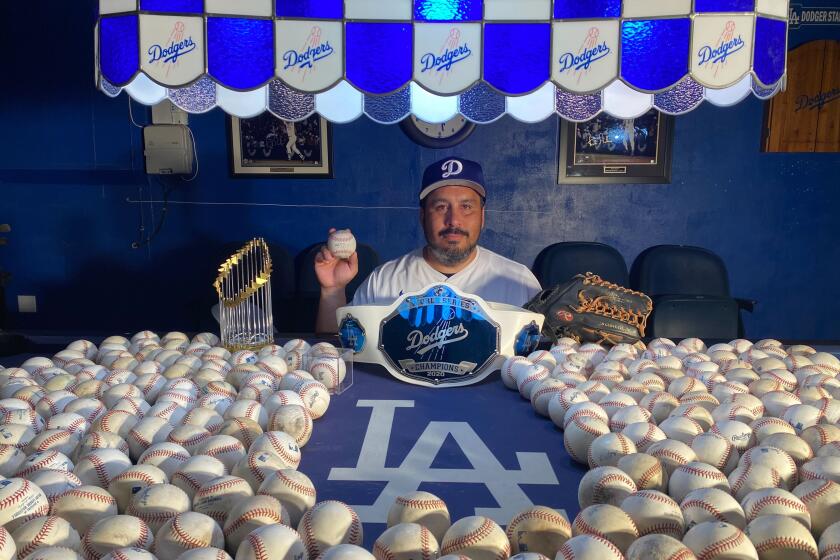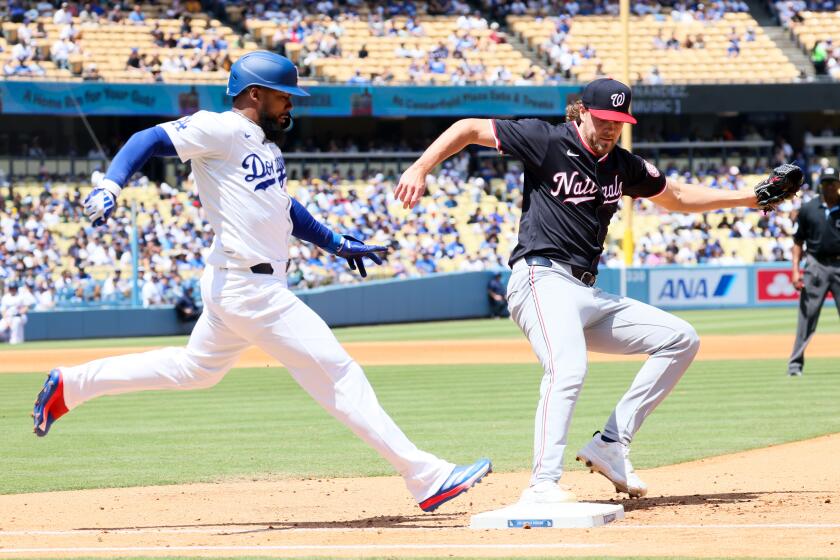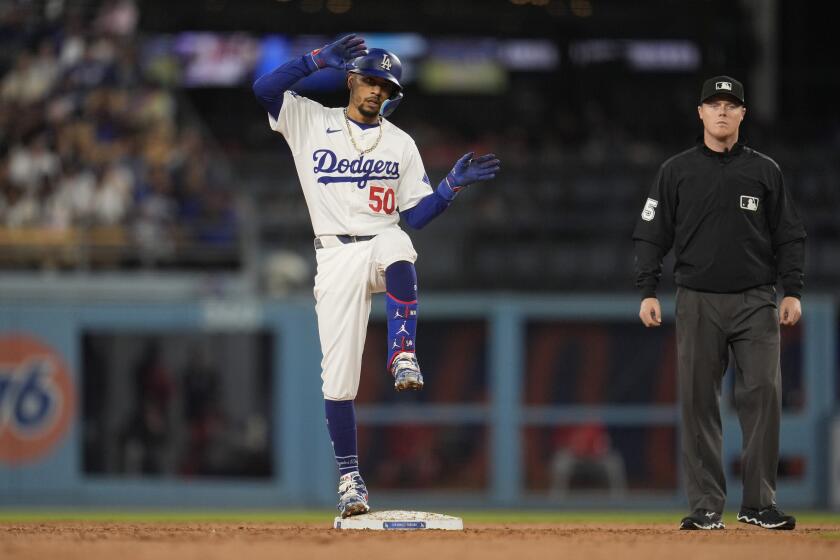Manny Ramirez is back with the Dodgers, but for how long?
When Manny Ramirez returned from the disabled list Saturday, there was a noticeable change in the far end of the Dodgers’ clubhouse.
Music could be heard. So could Ramirez, who was repeating to his Spanish-speaking teammates the same lines he was spouting to them months ago.
In a voice loud enough to be heard halfway across the locker room, he talked about how his life had become a soap opera. When a couple of reporters walked past his locker, he laughed and told his entourage, “They know I won’t be here next year.”
In reality, the end of Ramirez’s 2½-year tenure in Los Angeles could come sooner than that — if the Dodgers decide to dump the remainder of his salary and the former All-Star agrees to audition for his next contract elsewhere.
But even though the Dodgers are barely in playoff contention as they open a three-game series in Milwaukee on Tuesday, they don’t appear to be in sell mode. Not yet.
They were buyers as recently as Sunday, acquiring catcher Rod Barajas on a waiver claim.
“I want to see what we look like,” General Manager Ned Colletti said.
The Dodgers have hit .281 and scored an average of 5.3 runs in the 52 games Ramirez has started for them, according to STATS LLC. They’ve hit .241 and averaged 3.6 runs when he’s out of the lineup.
Ramirez’s first game in nearly a month, an 8-5 victory over the Cincinnati Reds, offered mixed signals.
Ramirez was 0 for 3 with two strikeouts, but the players around him hit. Whether it was out of respect to him or because they actually believed it, his teammates said his presence changed their slumping offense.
Andre Ethier, who was three for five with a home run that night, said he personally benefited from Ramirez’s return.
“I was excited to have him back,” Ethier said. “He’s still a threat. They’d rather take their chances with me. He has how many thousands of RBIs and hundreds of home runs and stuff? You definitely see a difference.”
So the Dodgers aren’t prepared to unload Ramirez quite yet.
Regardless, Ramirez is expected to land on the waiver wire sometime this week. (That hadn’t happened as of Monday, baseball sources told The Times.)
Most players are placed on waivers in August, as there is no reason for them not to be. A player who is claimed can be pulled back by his current team, which can keep him, let him go to the team that was awarded the claim, or trade him to that team.
If multiple claims are filed for Ramirez, a National League team would get priority over any American League team. And if it comes down to multiple teams from the same league, the claim would be awarded to the one with the worst record.
A player who clears waivers without being claimed can be traded to any team.
Because Aug. 31 is the last day a player can be added to a roster and still be eligible for postseason competition, the date serves as a trade deadline of sorts.
Ramirez’s situation is complicated by his contractual status.
If a team claims Ramirez and the Dodgers don’t pull him back, the claiming team would be stuck paying the remainder of his $20-million salary.
But of that $20 million, Ramirez will be paid only $5 million this year, with the rest to be paid over the next three years. A team that would assume the remaining $4 million or so of his 2010 salary would make payments to him using the same deferment schedule.
Ramirez has a say over where he goes; the full no-trade clause in his contract allows him to veto not only a trade, but also a waiver claim.
That means he could demand compensation for forfeiting his no-trade rights. Or he could simply waive them if he wants to get out of Los Angeles or audition as a designated hitter in the American League, which is what he is expected to do next year.
When Ramirez was on a minor league rehabilitation assignment last week with Class-A Inland Empire, the Texas Rangers and Tampa Bay Rays had scouts in San Bernardino watching him. The same scouts were at Dodger Stadium over the weekend.
The Chicago White Sox made a run at Ramirez at the nonwaiver trade deadline and could provide another landing spot.
The wild cards in the equation are the Boston Red Sox, whom a disgruntled Ramirez essentially forced to trade him in 2008. If the Red Sox figure Ramirez would reject a return to Boston, they could submit a claim on him for the sole purpose of blocking his move to a fellow AL contender.
But any such speculation is premature, Colletti insisted.
“I’m not there yet,” he said.
dylan.hernandez@latimes.com
twitter.com/dylanohernandez
Clicking on Green Links will take you to a third-party e-commerce site. These sites are not operated by the Los Angeles Times. The Times Editorial staff is not involved in any way with Green Links or with these third-party sites.
More to Read
Are you a true-blue fan?
Get our Dodgers Dugout newsletter for insights, news and much more.
You may occasionally receive promotional content from the Los Angeles Times.






